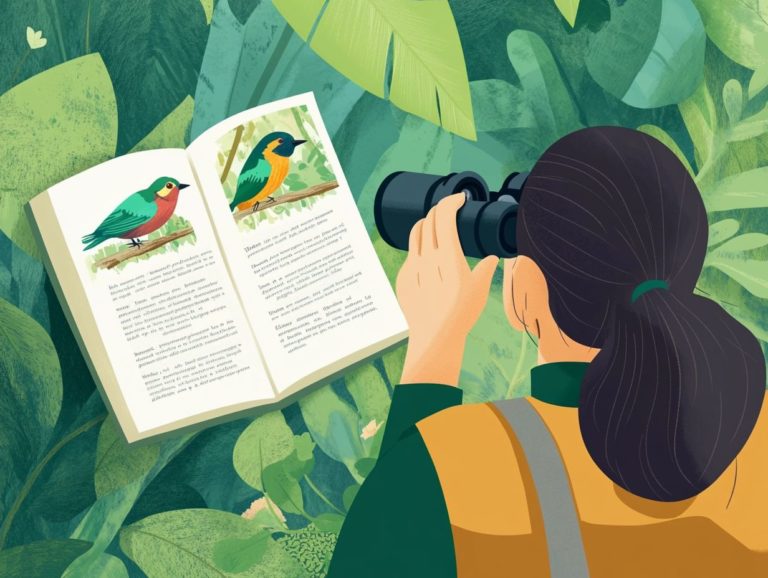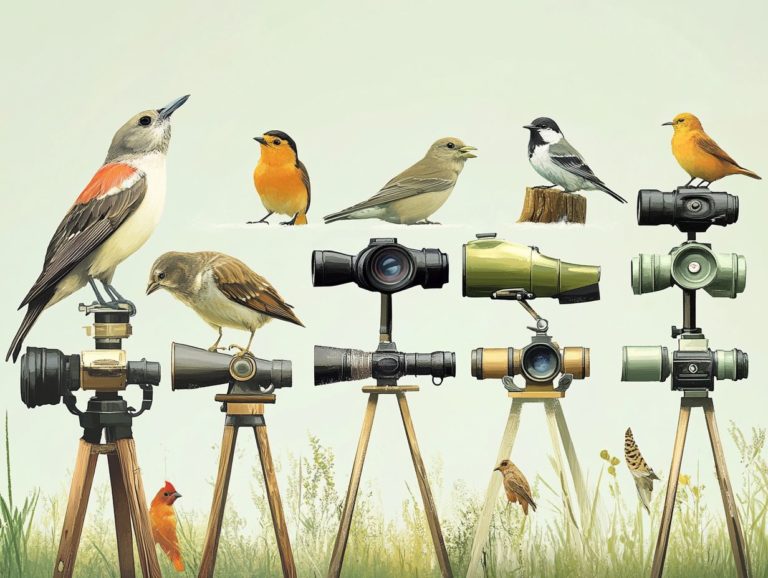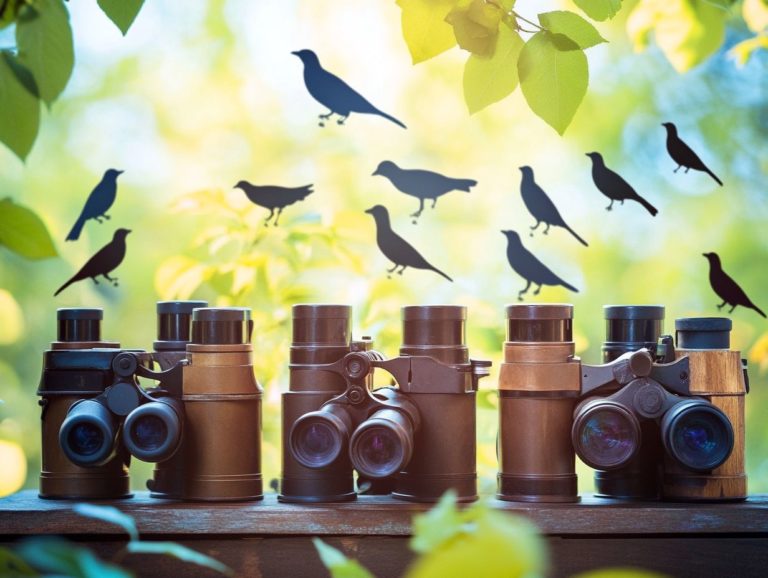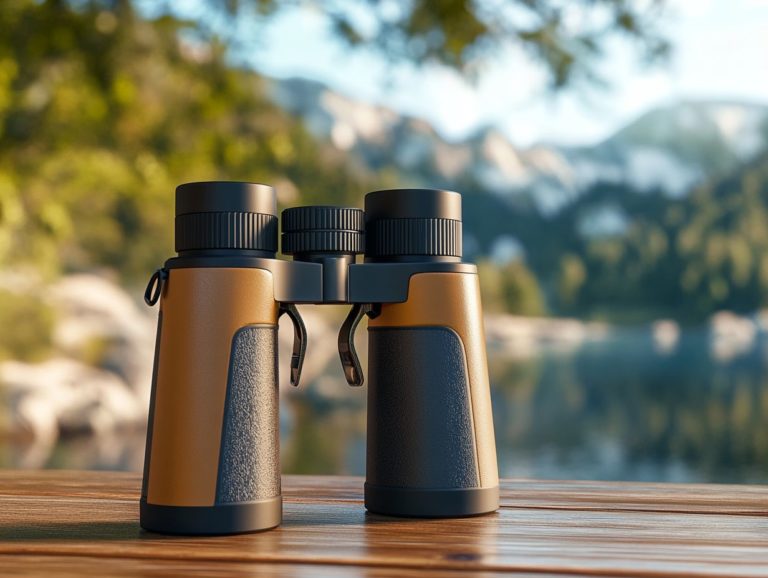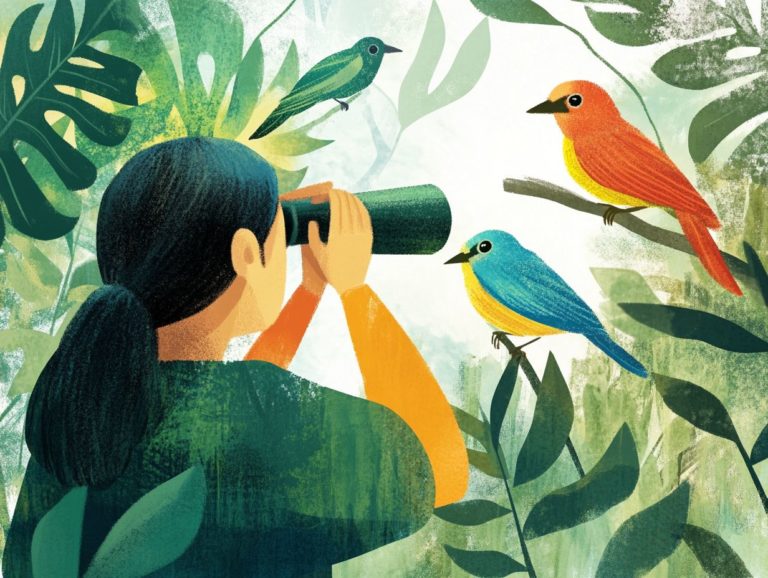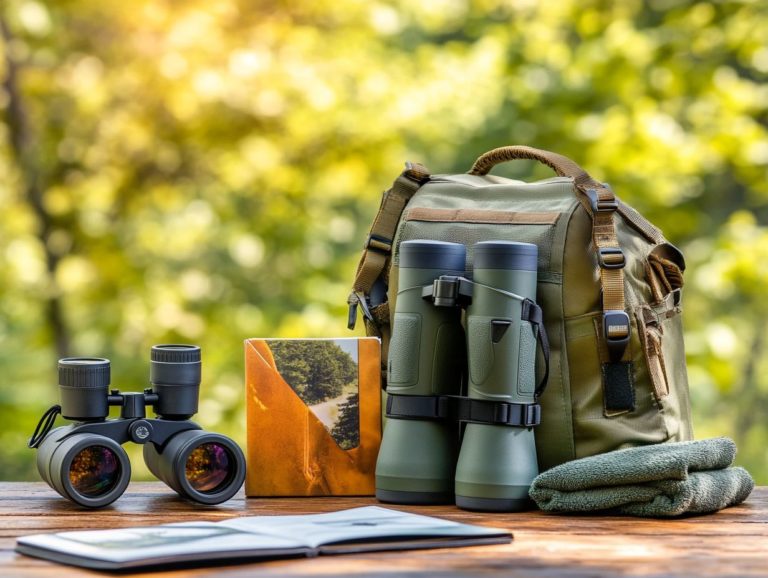The Best Binoculars for Kids Interested in Birding
Birding is an exciting way for kids to connect with nature, igniting their curiosity and cultivating a love for the great outdoors.
Selecting the right binoculars can significantly elevate this experience, enabling young birdwatchers to observe and appreciate the avian wonders surrounding them with ease.
This guide delves into everything from choosing age-appropriate binoculars to engaging birding activities. It offers insights on safety, educational benefits, and tips for fostering family involvement.
Leverage this information to nurture the aspiring birdwatcher in your child.
Contents
- Key Takeaways:
- 2. Factors to Consider When Choosing Binoculars for Kids
- 3. Top 5 Binoculars for Kids Interested in Birding
- 4. Educational Benefits of Birding for Kids
- 5. Safety Tips for Kids Using Binoculars
- 6. How to Foster a Love for Birding in Kids
- 7. Common Birds to Look for When Birding with Kids
- 8. Fun Birding Activities for Kids
- 9. How to Make Birding a Family Activity
- 10. Tips for Teaching Kids How to Use Binoculars Properly
- 11. How to Encourage Kids to Record Their Birding Observations
- 12. The Importance of Conservation and Birding for Kids
- 13. Budget-Friendly Options for Binoculars for Kids
- What Are the Benefits of Introducing Kids to Birding at a Young Age?
- What Are Some Common Features of Binoculars for Kids?
- How Can Parents Help Their Kids Develop a Passion for Birding?
- What Are Some Safety Measures to Keep in Mind When Birding with Kids?
- How Can Birding Help Kids Learn About Nature and the Environment?
- What Are Some Resources for Identifying Birds and Their Calls?
- Frequently Asked Questions
- What are the best binoculars for kids interested in birding?
- Why are lightweight binoculars important?
- What is the ideal magnification for kids’ binoculars?
- How can I ensure the binoculars are durable?
- What features should I look for in kids’ binoculars?
- Do I need to spend a lot on binoculars for my child?
Key Takeaways:

- Introducing kids to birding at a young age can have numerous educational and developmental benefits.
- When choosing binoculars for kids interested in birding, consider features such as size, weight, and durability.
- Parents can foster a love for birding in their kids by involving them in fun and educational activities, such as bird identification and recording observations.
2. Factors to Consider When Choosing Binoculars for Kids
Choosing the right binoculars for kids involves several important factors. To ensure a safe and enjoyable birdwatching experience, consider aspects like binocular size, a lightweight design, and good lenses that cater to your child’s needs. Additionally, pairing them with the best bird feeders for kids can enhance their outdoor adventure.
Zoom plays a crucial role too much power can make it tricky for young birders to locate and follow fast-moving feathered friends. Durability is another key factor; kids often drop or mishandle equipment, so opting for sturdy, shock-resistant models can save you a world of hassle later on.
Don t overlook the ease of adjusting focus; smooth mechanisms allow children to quickly adapt their view, enhancing their experience in the field. Selecting age-appropriate binoculars not only fosters independence but also maximizes enjoyment, laying the groundwork for a lifelong passion for nature.
3. Top 5 Binoculars for Kids Interested in Birding
Choosing the right binoculars can truly elevate the experience for kids. You’ll find a curated list of the top five binoculars specifically designed for children, featuring well-reviewed models from trusted names like Celestron, Nikon, Olympus, and Carson. For a complete birding experience, consider checking out the best educational birding apps for kids. These options provide quality optics and come in lightweight designs perfect for little explorers.
These binoculars are crafted for effective zoom, allowing young bird watchers to easily spot distant species. They also offer impressive field of view capabilities, enabling effortless scanning of sprawling landscapes. For those seeking the best options, check out the top 10 most popular binoculars for bird watching. Durability is crucial, especially for active youngsters, so you can rest assured that these binoculars are often shockproof and waterproof, ready to endure rough handling.
Comfort is also key, with ergonomic designs and easy-to-grip surfaces tailored for small hands. Parents rave about the ease of use and the memorable experiences these top binoculars for bird watching in urban areas create, making them a worthwhile investment for any budding nature enthusiast.
4. Educational Benefits of Birding for Kids
Birding presents a wealth of educational benefits for you and your children, providing an engaging way to explore nature and the environment. As they delve into the world of wildlife watching, they’ll sharpen their observational skills, cultivate patience, and develop a sense of responsibility towards the natural world.
Using birdwatching tools like binoculars enriches their experience, enabling them to catch details that might otherwise escape their notice. Through these activities, your young learners will enhance cognitive skills such as critical thinking and problem-solving, and improve their social interactions by sharing exciting discoveries with friends.
Discussing the various species they encounter sparks their curiosity and opens up conversations about ecosystems and the importance of biodiversity. This hands-on exploration deepens their environmental awareness, encouraging them to consider conservation and their role in protecting vital habitats.
By connecting with nature in such an interactive manner, children develop a greater empathy towards wildlife, fostering a lifelong appreciation for the natural world around them.
Start birdwatching today! Engage with your children in this fun experience!
5. Safety Tips for Kids Using Binoculars
Safety is crucial when kids use binoculars. Whether they re in the backyard or on a birdwatching trip, teach them key safety tips.
Adult supervision is vital during outdoor activities. It guides children and helps reduce potential risks.
Kids should hold binoculars securely. Swinging them around can cause accidents.
Teach kids to care for their equipment. Storing binoculars in a protective case keeps them safe and shows respect for their belongings.
6. How to Foster a Love for Birding in Kids
Fostering a love for birding in kids can connect them to nature. Start by introducing them to tools to help you watch birds, like compact binoculars for birding adventures.
Organizing family outings to local parks or nature reserves is a splendid way to engage young minds. It transforms birding into a shared adventure.
Using beginner-friendly bird identification resources, such as field guides or mobile apps, adds fun and interactivity to the learning process.
Introduce concepts gradually, allowing kids to explore their interests. Games like scavenger hunts for specific bird species can keep their energy up.
This delightful mix of play and education nurtures a lifelong fascination with nature and its avian inhabitants.
7. Common Birds to Look for When Birding with Kids
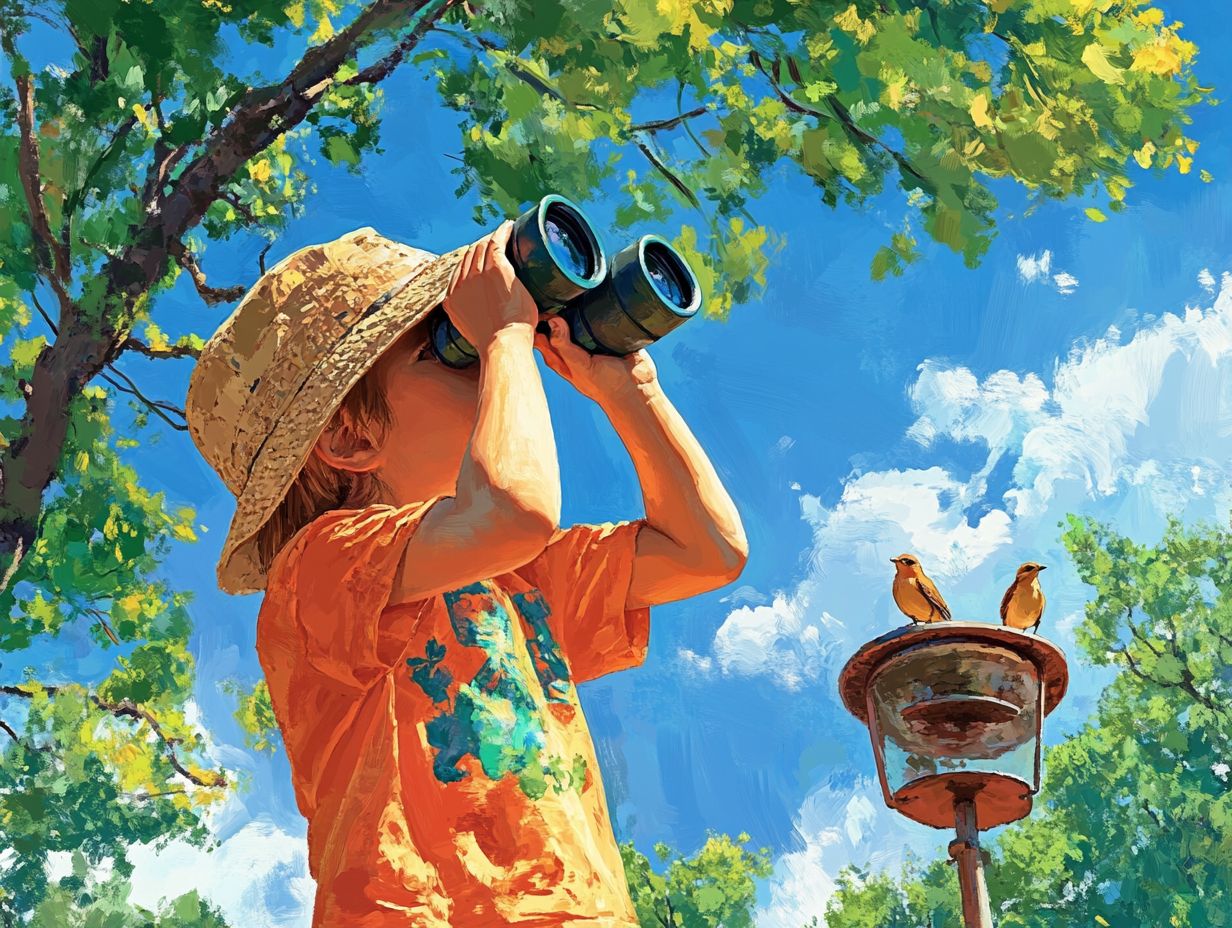
When you’re out birding with kids, spotting common birds can be a rewarding experience. It keeps their enthusiasm soaring.
Familiarizing them with local wildlife sharpens their bird identification skills and deepens their appreciation for the environment.
Take the American Robin, for example. With its vibrant orange breast and melodic song, it’s a fantastic way for children to learn by sight and sound.
Then there s the Black-capped Chickadee, a playful little creature often seen flitting between branches. Its distinctive call is a delight to hear.
As the seasons shift, so too do the birds. Spring brings the enchanting Eastern Bluebird, while colder months introduce hardy visitors like the Dark-eyed Junco.
To elevate the birdwatching experience, create a birding checklist for the kids. This fun tool helps them track sightings and teaches patience.
Engaging in this activity can spark a lifelong passion for nature. Get outside, explore, and make memories with your kids their love for nature awaits!
8. Fun Birding Activities for Kids
Engaging kids in delightful birding activities can truly ignite their passion for nature and birdwatching. These activities also help hone their observational skills. Whether it’s crafting bird feeders or organizing exciting scavenger hunts, the opportunities to make birding enjoyable and educational are endless.
Consider setting up birdwatching journals for your children. Let them write down what they see a perfect blend of creativity and attention to detail. Activities like building birdhouses or making DIY binoculars not only encourage hands-on learning but can also be tailored to fit various age groups. This ensures younger children have their fun while offering more complex challenges for teenagers.
Nature walks centered around local species can be equally adaptable. Younger children might revel in identifying colors and shapes. In contrast, older participants can dive into the fascinating world of scientific names (the official names scientists use for species) and behaviors. Exciting activities make learning about birds a fun adventure for everyone!
9. How to Make Birding a Family Activity
Birding can be a delightful family activity that fosters bonding and offers a chance to explore the great outdoors. By engaging in wildlife watching together, you and your family can share experiences, teach one another about nature, and create lasting memories.
To ensure a successful birdwatching trip, plan your adventures by selecting local parks, reserves, or scenic trails that are known for their avian diversity. Involving everyone in the planning process allows each family member to contribute their preferences. This enhances excitement and fosters collaboration. Bringing along a field guide to identify birds can spark educational discussions as family members share their observations and insights.
These outings enhance teamwork skills and encourage collaborative problem-solving when spotting elusive species. This shared commitment deepens family bonds while instilling a profound appreciation for the natural world.
10. Tips for Teaching Kids How to Use Binoculars Properly
Teaching kids the proper way to use binoculars is essential for elevating their birdwatching adventures. By showing the right techniques for adjusting focus and holding the binoculars, you can help them maximize their wildlife encounters.
As they embark on this enjoyable journey, guide them through the basics. Start with the correct grip encourage them to hold the binoculars with both hands for stability and comfort. Then, introduce them to adjusting the focus by turning the central wheel, enabling them to see distant objects clearly. Encourage them to practice by spotting nearby trees or birds. Watch how the magnification transforms their view!
Exploring the field of view is key; they can test this by identifying objects in their surroundings while gradually moving the binoculars. Incorporating fun games, like spotting different colors or shapes, can turn this learning experience into a delightful adventure that sparks their curiosity about nature.
11. How to Encourage Kids to Record Their Birding Observations
Encouraging kids to document their birding observations can enhance their engagement with the activity. It elevates their learning experience too! By equipping them with simple tools for recording their findings, you can ignite a sense of curiosity and responsibility toward nature.
Methods like keeping a journal or using digital apps can transform the process into something both enjoyable and educational. Journals allow for creative expression, where your kids can sketch the birds they encounter or note intriguing behaviors they observe.
On the other hand, digital apps come with exciting features like photo uploads and community sharing, fostering a sense of collaboration. Reflecting on their entries reinforces their understanding and nurtures a habit of mindfulness.
Sharing their experiences with friends or family can inspire engaging discussions. This further enhances their appreciation for the avian world that surrounds them. So, grab a notebook and start your birdwatching adventure today!
12. The Importance of Conservation and Birding for Kids
Conservation and birding are a great match. They offer a powerful way to instill environmental awareness in children.
When kids engage in birdwatching, they learn the importance of protecting habitats. This fosters a sense of responsibility from a young age.
As they observe different bird species, young enthusiasts begin to understand the delicate balance of nature. Engaging in activities like local clean-up days, building birdhouses, or planting native trees significantly enhances their knowledge and appreciation of the environment.
By joining community organizations dedicated to wildlife protection, children can witness the immediate impact of their contributions. Even simple actions, such as reporting bird sightings, provide valuable data for conservation efforts. Ultimately, these experiences empower them not only to care for local bird populations but also to advocate for broader environmental initiatives.
13. Budget-Friendly Options for Binoculars for Kids
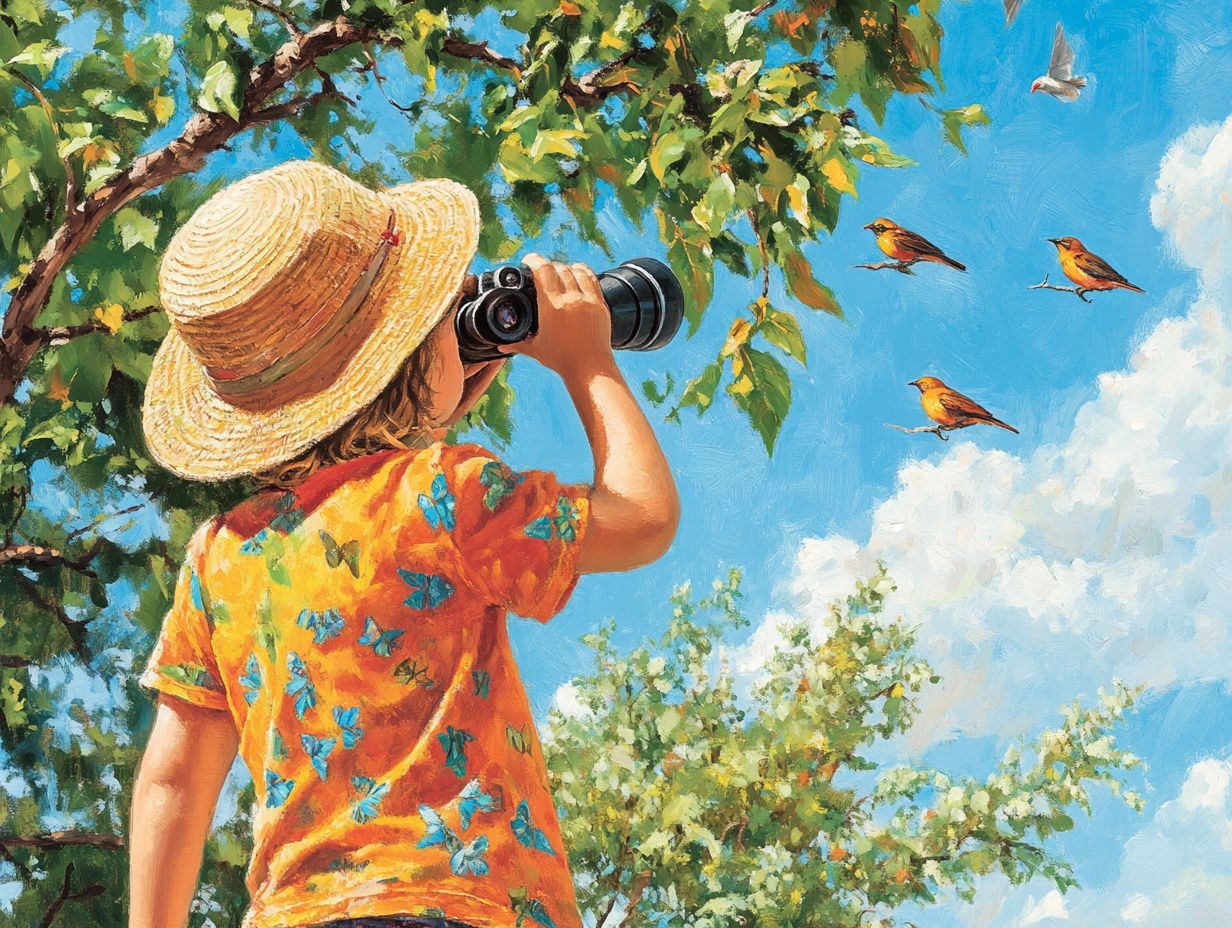
Finding budget-friendly binoculars for kids is exciting and easy! There are plenty of entry-level models out there that deliver quality optics and a comfortable experience without emptying your wallet. To enhance this experience, consider checking out the best bird feeders for children, making it simple for you to introduce your children to the delightful world of birdwatching.
Consider models like the Nikon Prostaff 3S and the Celestron Kids 5×30; they offer excellent image clarity and are built to withstand the rough and tumble of youthful adventures. Their lightweight design means even the smallest hands can grip them comfortably, making it easy for your little ones to use them time and again.
By investing in age-appropriate binoculars, you’re not just enhancing outdoor experiences; you’re igniting a sense of curiosity about nature that can foster a lifelong love for learning and adventure. For the best options, check out what are the best binoculars for bird watching trips. These affordable options empower young explorers to dive into their adventures with excitement!
What Are the Benefits of Introducing Kids to Birding at a Young Age?
Introducing children to birding at a young age opens the door to a world of benefits, including enhanced cognitive skills, heightened environmental awareness, and the nurturing of a passion for nature. Through the engaging practice of birdwatching, kids are likely to develop an enduring love for wildlife and the great outdoors.
Beyond fostering this appreciation, participating in birdwatching activities hones their observational skills. As they learn to identify various species, they pay close attention to colors, sizes, and behaviors, sharpening their ability to recognize subtleties in nature. This keen attention to detail can also translate into academic success.
Moreover, sharing the birdwatching experience with family instills patience. Waiting for that elusive glimpse of a rare bird teaches the invaluable lesson of perseverance. As they interact with fellow enthusiasts during casual or organized outings, their social skills flourish, encouraging meaningful conversations and teamwork essentials for cultivating lasting friendships.
What Are Some Common Features of Binoculars for Kids?
Common features of binoculars for kids often include lightweight designs, a comfortable grip, and age-appropriate optics that truly enhance the birdwatching experience. For those interested in more advanced options, exploring the best binoculars for twilight bird watching can ensure quality results while remaining user-friendly for young enthusiasts.
Essential features like magnification levels ranging from 4x to 8x strike the perfect balance, offering a clear view without overwhelming a young user s vision. A wide field of view is crucial, enabling young birdwatchers to track moving birds with ease and confidence.
Durability is another vital aspect. Many kids binoculars are crafted to withstand drops and rough handling, ensuring they last through countless adventures in enthusiastic hands. These thoughtfully designed attributes not only elevate the joy of birdwatching but also cultivate a deeper appreciation for nature among young explorers.
How Can Parents Help Their Kids Develop a Passion for Birding?
Parents hold the key to igniting their children’s passion for birding. Immerse them in outdoor activities and equip them with the right tools and encouragement. Through shared experiences, your children are more likely to forge a lasting bond with nature and wildlife.
To nurture this budding interest, participate in local birding events. Invite your children to explore the vibrant world of birds alongside seasoned enthusiasts. Setting up bird feeders at home attracts a variety of species and creates the perfect opportunity for your kids to observe these fascinating creatures up close.
Regular visits to local parks uncover different habitats and deepen their understanding and appreciation of nature.
By consistently engaging in these enriching activities, you cultivate curiosity and foster a lifelong commitment to wildlife conservation. Create unforgettable memories that inspire the next generation to admire the beauty of avian life.
What Are Some Safety Measures to Keep in Mind When Birding with Kids?
When you’re birding with kids, implementing safety measures is essential for a fun and secure experience. Guide them to safely navigate outdoor environments and learn how to use binoculars.
Choose birdwatching locations known for their accessibility and safety. Exploring unfamiliar areas can introduce unnecessary risks. Keep a watchful eye on your little ones not just for their protection but to nurture their appreciation for nature.
Teach them to handle binoculars responsibly to prevent accidents and mishaps.
Before heading out, check the weather, pack plenty of snacks, and bring along a first-aid kit. These small preparations significantly enhance your day. Being well-prepared instills a sense of adventure while keeping safety at the forefront.
How Can Birding Help Kids Learn About Nature and the Environment?
Birding is a remarkable gateway for immersing yourself in nature and the environment. It offers hands-on experiences that enhance your understanding of wildlife and ecosystems. Through birdwatching, you gain insights into biodiversity, conservation, and the critical importance of preserving habitats.
As you engage with the captivating world of avian life, you observe various species in their natural settings. You also recognize intricate migration patterns that highlight the interconnectedness of ecosystems across vast distances. This exploration encourages critical thinking about how changes in the environment like climate change and habitat destruction affect these feathered travelers.
Witnessing the effects of such changes firsthand cultivates a sense of stewardship and responsibility. This newfound awareness inspires you to advocate for sustainable practices and conservation efforts, fostering a lifelong passion for protecting the natural world.
What Are Some Resources for Identifying Birds and Their Calls?
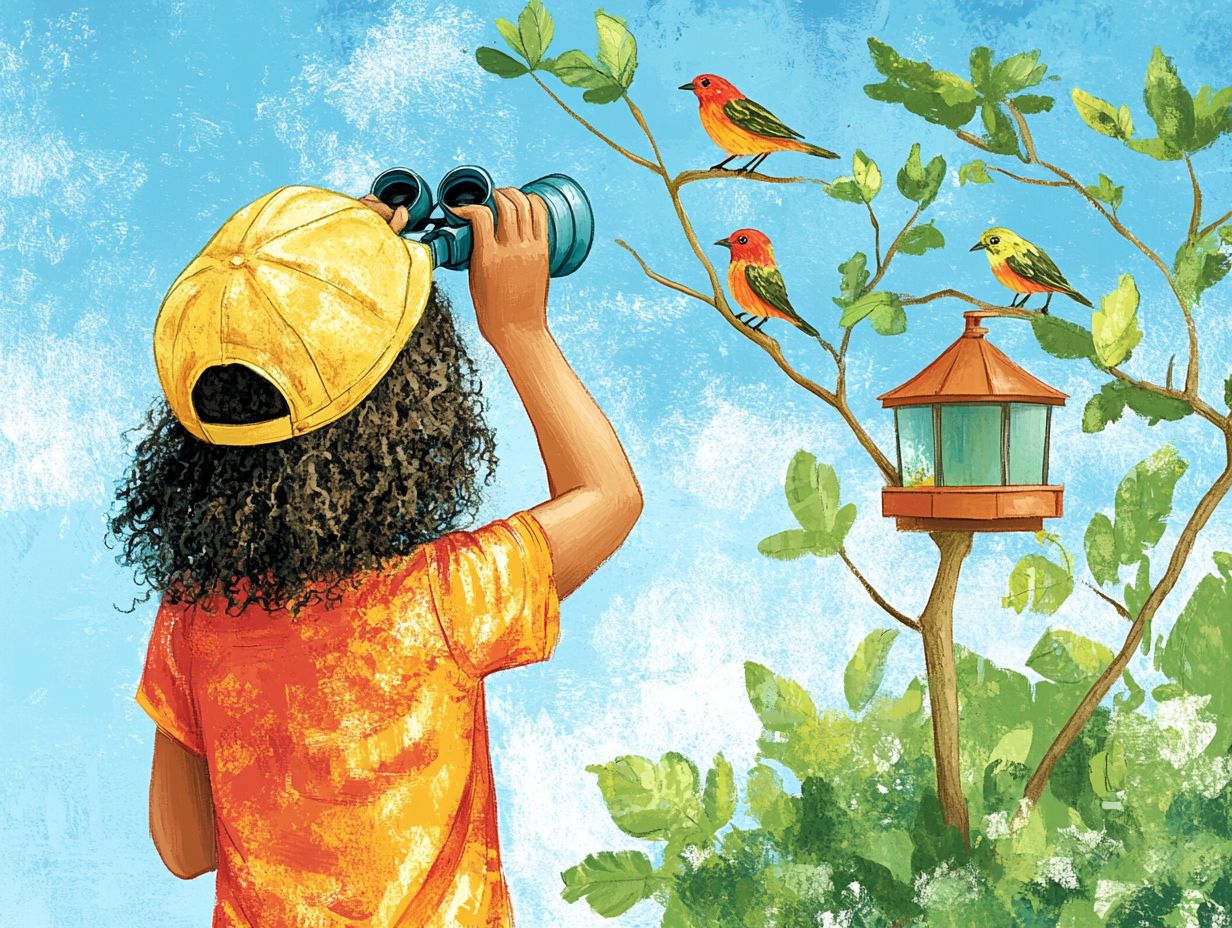
Identifying birds and their calls can transform birdwatching into an exhilarating adventure for you and your kids. There s a wealth of resources to support this journey:
- Merlin Bird ID app from the Cornell Lab of Ornithology: A brilliant tool that allows young enthusiasts to identify birds by answering a few simple questions about what they’ve spotted.
- AllAboutBirds.org: A treasure trove of resources, including engaging videos and insightful articles that deepen understanding of various species.
- Local organizations and community nature centers: Often host birdwatching events and guided tours, enriching your children s experiences while encouraging connections with fellow nature lovers.
These interactive platforms cultivate curiosity and responsibility towards the environment, making birding a truly rewarding and educational pursuit.
Frequently Asked Questions
What are the best binoculars for kids interested in birding?
The best binoculars for kids are lightweight and durable. When choosing, consider what to look for when buying birding binoculars, ensuring they have a magnification of 8x or 10x, which offers a great view without being too shaky.
Why are lightweight binoculars important?
Lightweight binoculars are easy for kids to carry. This means they can hold them for longer without getting tired.
What is the ideal magnification for kids’ binoculars?
Look for binoculars with 8x or 10x magnification. This gives a close-up view of birds without making the image shaky.
How can I ensure the binoculars are durable?
Choose binoculars with rubberized coatings or shock-absorbing features. High-quality materials and customer reviews can also indicate durability.
What features should I look for in kids’ binoculars?
Key features include a broad view, easy focus, and the ability to see clearly from 5 to 10 feet away. These will help kids spot and enjoy watching birds.
Do I need to spend a lot on binoculars for my child?
You don t have to break the bank! Many affordable options still offer great quality. Just remember to read reviews before buying.

